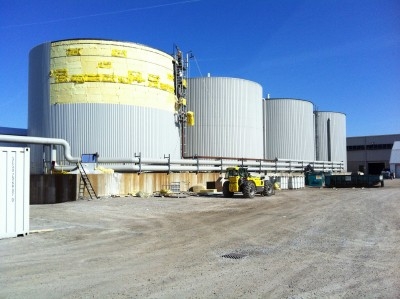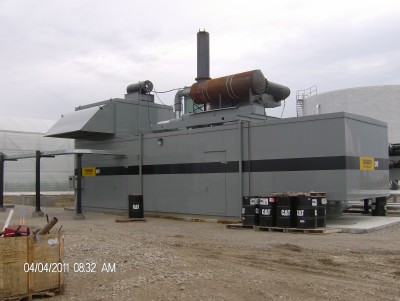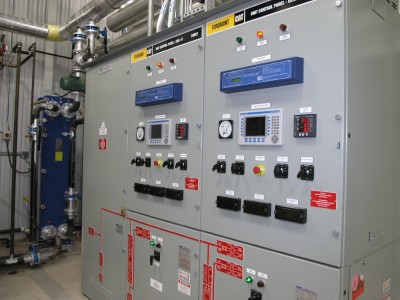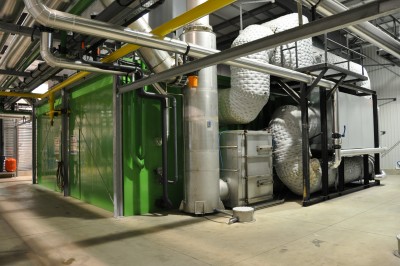
Features
Heating
Structures & Equipment
FEATURE STORY – Combined Heat & Power (CHP)
July 9, 2012 By Treena Hein
 Installed by European Power Systems, the cogen project at Soave Hydroponics includes four thermal storage tanks used to optimize heat and power production.
Installed by European Power Systems, the cogen project at Soave Hydroponics includes four thermal storage tanks used to optimize heat and power production. 2012 — Efficiency on the double: Energy Edge takes a close look at combined heat and power – who should consider it, return on investment, electricity feed-in tariff contracts and more.
Several large greenhouse operations in Ontario have taken the plunge into combined heat and power generation (CHP), and given current price differentials between fuels such as natural gas or biomass and electricity, more may follow.
Almost all greenhouse operations in Europe run on a CHP system, also known as cogeneration or cogen. They make sense for a variety of reasons, the foremost being the greenhouse sector’s significant heat needs, and the steadily rising cost of electricity. While electricity generation alone is typically 40 per cent efficient in converting fuel to power, adding heat recovery to the equation can bring that thermal efficiency to 90 per cent, a reality that suits greenhouses well, at least for the bulk of the year.
Whether a CHP system makes sense depends on a wide range of factors that include: heat and power needs (and thus crop lighting needs); ability and cost to tie into the existing energy infrastructure (gas in and power out); ability to obtain government incentive or power purchase programs (eg CHPSOP in Ontario); ability or willingness to operate and maintain a generating system, or find a partner to do so; your take on the relative future costs of electricity, natural gas or whatever fuel source you consider; and more.
The first step in deciding whether CHP is right for your operation is a feasibility study, and there are plenty of experts available to help. Union Gas has worked with numerous greenhouse customers to examine CHP feasibility – a number which has increased in the last couple of years due lower gas prices, says Union Gas power market development manager Richard Chan.
“The ideal greenhouse CHP candidate is very ‘in tune’ with their operation and wants to reduce energy costs,” he explains. “Having old heating equipment that needs to be replaced anyway is also a good driver to install a new CHP system. But even if your equipment isn’t ancient, CHP may still be an excellent decision.” Chan says it costs $1.5 million to $2 million per MW to construct a CHP system. “ROI comes in three and a half to five years, depending on the capital costs and the energy savings achieved,” he notes.

(The prospect of running CHP systems can be daunting to greenhouse staff not used to the technology, but those contacted by GHC for this article did not find maintenance issues overwhelming. Finding a technology partner you are comfortable with is key. Photo: Greenhouse Canada Magazine)
The feasibility study will include a close look at a greenhouse’s ‘energy load profile’ – its electrical energy usage profile and associated cost, and its thermal energy usage profile and associated cost (see ‘Checklist’ sidebar). Those with crops that demand extensive artificial lighting are particularly appealing, as they have both high internal heat and power needs.
“You also have to look at electricity cost and natural gas costs closely,” Chan notes. “Electricity costs are going to keep rising in Ontario, with coal being phased out, nuclear plant upgrades and many other things going on, and if you’re relying on electricity, your costs are going up. The price of gas is very low right now and expected to remain low for many years because of abundant supply, and the forecast is for no increase in the near-term to mid-term. We are looking at very stable prices and abundant supply.”
Chan points to ICF International, an international multi-industry research firm, which says the North American natural gas resource base could support current levels of gas use for about 150 years. ICF International is not alone in this forecast. At recent renewable energy conferences attended by GHC’s sister publication Canadian Biomass, the consensus was that historically low natural gas prices are here to stay. “Any technology that competes directly with natural gas would make a poor bet right now,” explained one investment banker at International Bioenergy held in Prince George in mid June 2012.
Chan adds that “It’s the spread between gas and electricity that creates a great opportunity for looking at CHP today as opposed to a year ago, or five years ago,” a sentiment echoed by some of the CHP producers GHC has been in touch with over the past few months. That “spark spread” is what determines the most profitable times for operations to produce, and possibly sell, power. What makes that spread more appealing for cogen is that while electricity-only power generators would typically use 50% efficiency in converting natural gas to power (or .5) to calculate that spread, greenhouses from September to April can also include the “waste” heat in that calculation, driving efficiencies much higher.

(By combining electricity generation with heat recovery, efficiencies can top 90 per cent. The trick is fitting the opportunity into your unique demands.)
A look at contracts
Of course energy futures can be a risky business, which is why mechanisms for reducing the risk, such as incentive contracts are so important, notes Joe Van Schaick, market manager for power generation systems at Brampton, Ontario-based Toromont. “It’s a known revenue stream you can count on for many years,” he says. “Unfortunately, the CHPSOP (standard offer program) most recently offered by the Ontario Power Authority (OPA) is not well-suited to greenhouse applications – the fluctuations in energy requirements throughout the year are a challenge. The CHPSOP program is set up for businesses that use energy more consistently, and therefore, I think the greenhouse industry could use its own CHP program.”
Soave Hydroponics Company in Kingsville, Ontario signed a CHP RFP ‘1’ agreement with OPA in 2006 (see chart for details on their CHP system). Rather than receiving a locked-in rate for the electricity it feeds into the grid, the company’s contract specifies a floating price that’s continually re-calculated based on the ratio between electricity and natural gas prices per unit of energy, and the value given to heat during the year (known as the ‘heat rate’).
“It makes sense for us to generate power if we can buy natural gas at, for a simplified example, $5/GJ, and the base electricity price that hour is $50/MWh, because power is in demand,” says president and general manager Guido Van Het Hof. “A ratio of 50/5 gives me a heat rate of 10, which makes it viable to run, (not including a small provision for maintenance cost). But if electricity demand drops, there is no point.”

(The cogen system at Soave Hydroponics supplies 75 per cent of the vegetable grower’s heat needs as well as provides the opportunity to put power on the grid.)
The generators generally come on several periods in a day at various points in the season. However, Van Het Hof adds that “If at such a time that it makes sense to produce and sell power, but we aren’t running our generators due to maintenance or whatever other reason, we lose out on the economic opportunity.” He explains that challenges aside, their bid was a wise decision based on the efficiency of using the heat and CO2 by-products of the reciprocating natural gas engines.
Still, Van Het Hof thinks it’s unfortunate that the grid isn’t currently maximizing the advantage of flexible power sources like CHP systems. “We need sources that can instantly help meet peak demand and then be turned off,” he says. “Most types of power generation such as nuclear, wind and coal can’t provide this flexibility.”
“CHP systems could provide power a lot more cost-effectively,” he says. “The province needs to look at which power sources should run, with efficiencies and especially price kept in mind. CHP is a perfect fit to provide affordable, efficient and flexible power, and greenhouses are especially suited to this as they use the heat and CO2.”
Other options
Greenhouses can also choose the CHP arrangement known as ‘self-displacement’ or ‘behind the meter,’ where all the electricity and thermal energy produced is consumed onsite. Van Shaick thinks that based on today’s low natural gas costs, it makes sense for greenhouses to go this way, and Chan says some in Ontario have done so. A less-complicated design is required in comparison to a system where electricity is fed into the grid, he says, and this arrangement also allows a business owner to avoid things like the monthly reporting and surprise audits specified in an OPA contract. It is a set-up that likely works best for growers with heavy lighting needs, and thus power loads.
Van Shaick also notes that the connection of distributed power generation involved with OPA contracts is a process that can be very onerous – mostly because of the many large projects that compete for Hydro One’s personnel resources. “The time required to receive approvals is a major barrier for the average greenhouse grower,” he says. “Decisions relating to small businesses need to be made more quickly than what the CHPSOP has allowed, delaying return-on-investment from beginning to occur.”
Jeff Blunt, Union Gas greenhouse account manager, agrees. He says that some greenhouse operators who went with a government feed-in contract have needed to be more persistent than they had foreseen to get the approvals finished. To mitigate this, he stresses the importance of investing time in your pre-plan. “Advanced planning should include completing engineering studies with engineering companies that have experience in cogeneration, making formal inquiries to the electrical and natural gas companies about connection requirements and undertaking financial feasibility studies for behind the meter generation or government contract for generation,” he notes. “It can take a lot of coordination to get your approvals done, but the key is to pre-plan and stay persistent.”
On a hopeful note, Van Schaick points out that the Ontario government has recognized the difficult and onerous nature of approvals and regulations relating to on-farm biogas operations, and has streamlined things in recent years. “Hopefully, they will do the same for greenhouse operators,” he says.
In addition to having a less complex design and avoiding reporting and audits, going with a ‘self-displacement’ CHP arrangement also means, says Chan, “you only need to produce the power you need, so it’s going to be smaller as well, than if you’re selling to the grid.”
At its 110-acre vegetable greenhouse in Delta, BC, Village Farms is purchasing heat generated from biogas collected at the city of Vancouver’s Delta landfill site. The CHP system there was installed by Maxim Power in 2003, and involves a 20-year feed-in tariff contract with BC Hydro. The four gensets use scrubbed biogas to produce 7.2 MW. Under a contract of unspecified length, Village Farms purchases heat recovered from exhaust, waterjackets, intercoolers and oil exchangers, which they use to provide 90˚+ C water to a boiler. Spokesperson Doug Kling says that the cost of this heat is generally lower than it would be to produce heat using natural gas.
While it’s clear that CHP systems can be an ideal fit for greenhouses, the range of options available and some of the challenges involved mean homework and likely expert advice are needed for new entrants. Opportunities abound, but in an ever-evolving power generation landscape, the need for detailed research in a CHP decision has never been more important.
Treena Hein is the Energy Edge editor and an award-winning science&techology writer.
Details of some larger CHP greenhouse systems in Ontario:
Rosa Flora in Dunnville, ON – 2011
Rosa Flora has a NUG contract (non-utility generator) contract with OPA (the Ontario Power Authority). They have a Caterpillar natural gas generator. It is the company’s fourth unit, with the first two Cat 800 kW (electrical) installed in 1991, and the most recent pair of Cat 2 MW units producing 5.6 MW of electrical and 8 MW thermal. The units also allow tri-generation, injecting CO2 into the greenhouses from the generator stacks. Also have three million litres of hot water storage (heat buffer).
Seacliff Energy in Leamington, ON – 2011
Seacliff has a 20-year FIT (feed-in tariff) OPA contract. The operation has an innovative two-stage biogas digester paired with a Caterpillar low-emission genset. They produce 1.6 MW of electricity plus heat to warm the adjacent cucumber and tomato greenhouse (Pelee Hydroponics). Two-stage digesting is a mature technology in Europe, with over 5,000 units running. It is new in North America.
Great Northern (Soave) Hydroponics in Kingsville, ON – 2006
Great Northern signed a CHP RFP ‘1’ (no fixed electricity rate) agreement with OPA. They use a natural gas GE Energy’s Jenbacher ‘CO2 fertilization cogeneration system.’ The 12 MW GE/Jenbacher (four 3-MW) engines can supply about 75 per cent of Great Northern’s heating requirements. They rely on traditional boilers for some heating during the coldest winter months, because the cogen system was sized for the company’s CO2 needs, and not specifically for its heating requirements.
Recent feature stories on these CHP systems:
Rosa Flora
Seacliff
Great Northern (Soave) Hydroponics
CHP Resource Kit (Adapted and expanded from information from Union Gas.)
Why consider CHP? Having a CHP system…
– Reduces the amount of electricity that must be purchased from the grid
– Can allow for decoupling from the power grid, so that you avoid electricity price increases
– Provides a secure emergency power backup option
– Increase overall plant efficiency
– Improve power quality and reliability
– Allows a business to achieve ‘green benefits’ they can market to the public, such as lower emissions and reduced production of wasted energy (heat)
– Possibility of “low carbon” products thanks to C02 injection (tri-gen)
If you answer ‘yes’ to many of these questions, CHP is worth considering:
– Could you improve the efficiency of your energy use (e.g. by capturing waste heat and CO2)?
– Do you have aging equipment that needs replacement anyway?
– Are you concerned about electricity rates escalating rapidly?
– Is your crop both heat and light intensive?
– Do you feel more comfortable controlling your electricity costs more closely?
In deciding if CHP is right for you, consider:
– Your electricity usage profile and electricity costs
– Your thermal usage profile and thermal costs
– Cost of natural gas burner tip
– Cost of an electricity outage
– Your ‘hurdle rate’ for simple payback (timeline for ROI)
– Existing infrastructure – delivered cost of fuel (gas or biomass); ability to hook up to the grid
Some third party providers for CHP projects in Ontario and beyond:
CEM Engineering
EPS Energy
FVB Energy
Gryphon International Engineering Services
Toromont Energy
Updates on BC Hydro’s and Ontario Power Authority’s Standard Offer Programs
BC Hydro’s SOP encourages the development of renewable power projects of no more than 15 MW. Nine projects are in place (6 hydroelectric and 3 biogas) and 13 applications are being considered (all hydroelectric).
OPA’s CHPSOP existing projects range from about 2.5 MW to over 400 MW. OPA stopped receiving bids for this program on August 31, 2011. “The government is currently looking at a number of initiatives in light of the current supply situation in order to determine which initiatives should move forward.” The 12 existing CHPSOP contracts equal 972 MW (only one, Great Northern Hydroponics, features a greenhouse). Two more are under development.
OPA’s CHP electricity contracts page:
The most recent OPA Electricity Supply Report includes a chart of contracted facilities in commercial operation and contracted facilities under development (pg. 20 & 21) 08.pdf
OPA’s FIT (feed-in tariff) program for renewable energy is also still available.
Treena Hein is the Energy Edge editor and an award-winning science&technology writer.
Print this page